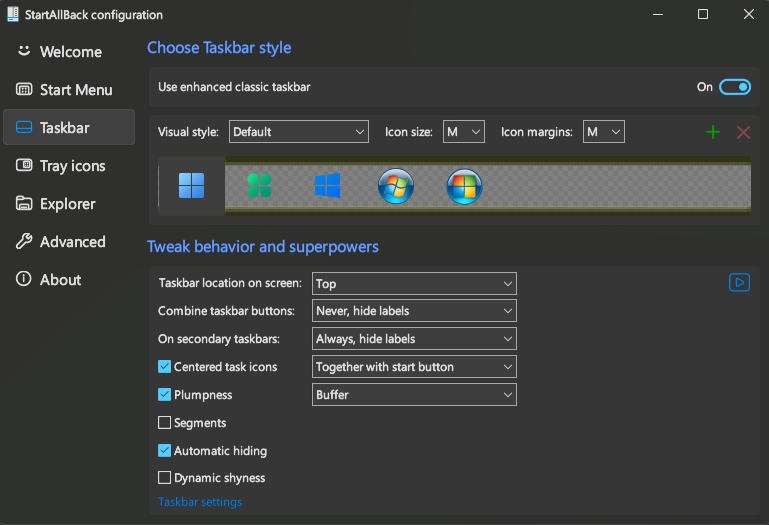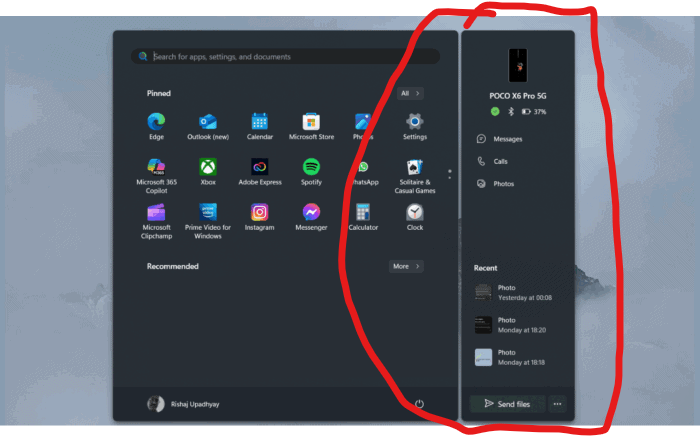All Activity
- Today
-
Hi ; well, cmalex's py3.11.4 assemblies (one compatible with just XP and one with Vista+) aren't currently being hosted on GitHub (AFAIAA), but they can be ; OTOH, adang1345's py3.13.7 assembly is already hosted on GitHub, and so is 3dyd's custom PyInstaller build used to make the Win7/Vista yt-dlp distributions; it may be possible, at least in theory, to author a modded GA workflow file to point to the custom implementations of CPython+PyInst necessary to package the Win7/Vista builds; e.g., upstream are using their own, custom, build of PyInstaller to create the "official" yt-dlp releases; perhaps a consultation with your "AI friend(s)" (or a question on SO, etc.) could prove beneficial in fully automating even the (currently) manually created release assets ; just a thought from a dedicated (hardly intelligent ) friend of yours... Best wishes !
-
Interesting Reading on the Internet in Today's World
NotHereToPlayGames replied to Monroe's topic in Technology News
Agreed. I remember when "annoying" used to be (depracated) MARQUEE to scroll text. EVERY web site you went to had these d@mn things. Way back then, the "not old people" learned how to combat the annoyance. And it's still us that do that combat nowadays. ie, I didn't even realize the web site had a "blue privacy/cookie notification". This is all I've ever needed for those -- https://greasyfork.org/en/scripts/432050-anti-cookies-consent -

Interesting Reading on the Internet in Today's World
Tripredacus replied to Monroe's topic in Technology News
IMO the internet got 'bad' once 'normal' people found it. But I think that is more nostalgia for the most part. As for when that happened, I'd say (at least in the US) that happened once Classmates came around. Everyone who was in high school or college went onto there to keep touch afterwards. That site got stepped on by Facebook which was originally designed for college students, but became so popular that old people joined it to keep in touch with those who were on it. For the current generation that is moving into the world, Facebook is seen as a site for old people which is a quote I've heard from multiple people of the younger generations, an insight I am afforded since I 'moonlight' at an arcade. This is only my perspective on things, but normal/old people from 20 years ago were basically computer illiterate, and astonishingly, people of that same stereotype in the current day are still mostly computer illiterate despite having grown up in with computers in a fully connected world. Combine that with the mentality that corporations have of treating adults (employees) like children and you end up with web technologies designed to protect the computer illiterate but in a fashion doesn't feel like the correct way to do it. I find it amusing that the link to this article on the Guardian brings me to a page where half of it is covered by a blue privacy/cookie notification. But overall I think that there are certainly many good points about how the internet has evolved and it is actually better in many ways now than it used to be. It is certainly more useful, something I didn't really grasp because I never had a mobile phone that was new enough to do anything cool until just recently. I think it will get better and we will figure out how to evolve it to deal with the current issues it has. There are more eyes on it now than ever before and that means more ideas of how to do things will occur. But that doesn't mean that there won't be some new dumb trend that everyone adopts that we'll have to deal with. We may end up looking back and laugh about how we were all bent out of shape about captchas and cookie banners in the face of whatever annoying thing we'll be having to deal with. -

My Browser Builds (Part 5)
Joseph_sw replied to roytam1's topic in Browsers working on Older NT-Family OSes
YouTube's comments history & live chat, both claim NM28 to be "unsupported browser", which obviously misinformation / false claim by Google, because both of it would work if I simply override the user-agent . -
I have observed that WinXP only handles 4k disks correctly (on all my motherboards, so no bluescreen after first restart, not S-ATA) when updated to (I use @harkaz's patch packs) Unofficial SP4 - that is up to 2014, I believe. Of course I put his EOS SP4 also - to get systems to 2019 state and the two contain many useful fixes besides the official updates.
-
Interesting Reading on the Internet in Today's World
NotHereToPlayGames replied to Monroe's topic in Technology News
EXACTLY !!! And when you call up the tech support, tell them a little White Lie of "my bank account has a million in it and there is none of these puzzles to solve to access that million, so DO NOT tell me that you do it for 'security' or every bank on the planet would be using these puzzles but NONE OF THEM DO, it's only folks like you, never government web sites, never banks, never insurance companies, never pharmacies, never anything that NEEDS TO BE SECURE, it's always always always you RETAIL FOLKS breaking down PRIVACY all in the guise of 'security'." -
qfonline joined the community
-
It doesn't have to unpack the executable to the TEMP directory each time yt-dlp is executed, so it loads a bit faster and doesn't wear your disk that much. The disadvantage is, that you can't update it with `yt-dlp -U`. Around 20 minutes. I have to fire up different virtual machines, each with different Python installs. I only have to build the custom ones for XP, Win7 and Linux_x86. The rest is done by GitHub Actions workflow.
-
yt-dlp_win7.exe is the usual one. What is the advantage of using yt-dlp_win7.zip with extracted libraries to _internal? How long does it take to prepare more than a dozen builds for an update?
-
Interesting Reading on the Internet in Today's World
EliraFriesnan replied to Monroe's topic in Technology News
It always was. An overpriced China rubbish. I can purchase much higher quality stuff near my house with cash, much cheaper, like 3-5 times less. Bought an AEG fridge for just 700 Swiss Francs (800 Euro) locally, while at Amazon it was like 1700 or more. -
Interesting Reading on the Internet in Today's World
EliraFriesnan replied to Monroe's topic in Technology News
Why not simply ignore those sites? And if you paid for a service (streaming, for example), bombard their tech support until they remove it. Demand money back, etc. -
Interesting Reading on the Internet in Today's World
EliraFriesnan replied to Monroe's topic in Technology News
Do you have troubles with using cash? Like @VistaLover described about "outlawing" certain Euro bills in EU by the Greek (or other) governments. https://msfn.org/board/topic/186106-r3dfox-a-modern-firefox-based-web-browser-for-windows-vista-7-and-8/page/16/#findComment-1282311 -
G'day from Australia, I'd like to propose a few feature additions: Ability to re-order all items in the right side of the start menu Ability to add and re-order separators/dividers in the right side of the start menu When a custom folder is added to the right side in menu mode, it would be great if you could open that folder in explorer when double-clicked (or give an option specify a custom action). Thanks again for StartAllBack! If you implement the above changes I'll buy a 20 license pack and gift it to my family and friends.
-
aktive joined the community
- Yesterday
-
A working browser, reliable virus-checking and the ability to work with 4TB+ HDDs make a computer/operating system useful in 2025 and later, at least for me. WinXP without these three capabilities is of limited use. Two of my computers work already fine with 4TB GPT HDDs under WinXP/2003 (read/write, partitioning. virus-checking, watching movies, Beyond Compare. Sandboxie, etc) WinXP on these 2 computers is "SP3-only", and does not contain "all updates until end of support" nor "all of the extended support updates". My first set of two 4TB GPT HDDs (Master+Backup) was created under WinXP SP3 and Win2003 32bit SP2, with both 4TB HDDs partitioned unaligned, i.e. by setting "Legacy" mode in Paragon HDM12 before creating the partitions. The first set of 4TB HDDs has worked mostly fine under WinXP/2003/Win10. I will now create more sets of 4TB+ GPT HDDs, containing different accumulations of stuff, mainly for use under WinXP/2003. Before starting to partition the 4TB+ HDDs under WinXP/2003, however, I will have to decide on the setting: Legacy [=unaligned] or Vista [=aligned]. The wrong choice may mean that eventually 100TB+ of stuff may have to be copied again Working under WinXP with GPT HDDs <=2TBs is easy, maybe a good exercise for getting acquainted with GPT under WinXP. Working under WinXP with GPT HDDs >2TB, however, is the tricky part. MiniTool Partition Wizard v11.4 (last version for WinXP), for example, doesNOT work under WinXP with GPT HDDs of any size (<=2TB and >2TB): an OK partitioned 4TB GPT HDD gets displayed as having a single partition and nothing happens when you right-click on it. My currently preferred software for creating partitions on 4TB GPT HDDs under WinXP/2003 is Paragon Hard Disk Manager 12 v10.1.19.16240 (Server, 25Nov2012). In PHDM12 the blue screen installer bug of GPT Loader of PHDM11 was fixed, it contains the last version of their old [=well-tested] partitioning engine, no .NET Framework. Paragon removed from PHDM12 the huge Total Defrag component, maybe issues defragging with PHDM11 under WinXP a 4TB GPT HDD?
-
And I have at least 2 that do not; that's not helpful.
-
I have at least 2 PCs of Ryzen 5000 generation, that do it. That are running 24H2 11 IoT/LTSC.
-
I can't reproduce that or explorer position not saving. It's clearly dependant on one of the myriad A/B feature switches, maybe vivetool output showing enabled features would help
-
I've also been having this problem on the latest cumulative update and 3.9.16 doesn't seem to fix it fully unfortunately. I have a 2 monitor setup and it usually manifests on either one at random after each reboot where the taskbar will be stuck stuck as a fully transparent one with icons/items/time visible, but still acting like it is hidden so windows can fill the space and get overlaid with the icons/etc. In my case, it seems to more often than not be my non-primary monitor upon reboot/login and I can usually fix it by manually flipping auto-hide on and off again, but sometimes that doesn't work either or it will be on my primary instead and not be fixable with flipping auto-hide, it's very random. Would love to add any logs/dumps or test possible fixes! Autohide off (both in Settings -> Taskbar and SAB 'Automatic hiding/shyness' settings off): Autohide on: Settings (enhanced classic start menu on):
-
Uiti P. Uszer started following StartAllBack for Windows 11
-
Were you able to address the issue of the Menu bar in File Explorer not continuing to display even if the check is marked for it to display? To display the Menu Bar in File Explorer, each time you open it, you have to uncheck to display the Menu Bar, then recheck it to display it. But the next time you open File Explorer the Menu Bar doesn't display even though it is check marked to display.
-
fr0stycam joined the community
-
frisser joined the community
-
Ok. Thanks for the reply. Love your work. Keep it up and thank you
-
frewys started following phone link compatibility
-
Hi. I haven't used StartAllBack in a while as I have explored Start11 They are lacking support for the phone link. Is that anything that works or plans to make it work in the future with the start menu?
-
a alignment is made for a "piece of area" if you have a "align area" for 1 MB (aka 1´048´576) then 2048 sectors of 512 bits would fit in there (or 256 sectors of 4k (4096)) if you dont have a "align area" that rounds up correctly it might lead into a sector, cluster, track, cylinder, whatever in between a other if you have a area like 4k (4096) * 4 = 16384 but you made that area +1 then the area overlaps into the next 4k sector then it use up 5, 4k sectors while the other data is not used, maybe corrupted the 512 bit and 4096 bit sector question been around for a while now, the hardware/firmware can also handle this - in this case this in then made in the harddrive/firmware not the operation system anymore if the firmware handles that right it can emulate logical and physical sectors - a drive is made at least of 4 maybe more parts (cluster, cylinder, sector, head) - its a combination not a single piece like "i want this specific sector, like just an "offset you enter - and thats it? no" " this is very common for other electronic parts to translate something like this for example a "logical address" to a "physical address", or segmentation (thus 32 bit can write past 4 GB) where the electric signals in the ram apear is then part of that -hardware piece-, the hardware piece control that or in case of a harddrive in hand´s of that firmware - what later then translate this to a physical thing on the harddrive - thats it this also make the -32 wires question- come out again - a USB only has 4 wires (where 2 are rather a power supply - if you notice the light on your usb mouse it probaly get powered by this, the smartphone charge should be also a such example), rather 2 wires of the USB are used for "transfer and control - what then is limited by frequency that wire can do" - but a usb cable can write to a "terabyte + harddrive" - you dont need always 32 or 64 wires to do this (with 2 wires you would have a offset 2*2 = 4 , 4 wires 2*2*2 = 16) (there are such model´s who use 32 wires and control wires - but it is not always a must - if i remember right with FSB there was something done the ram only had 200 mhz but "quadpumped" its 800 FSB (that might bring out someones memory´s) - the cache and the TLB of the cpu can do this) i wonder why no-one has made the related change in the windows xp operating system yet - basicly it sounds simple to ask the harddrive what sector-size it uses (sometimes called the AF (advanced format)) but its just 4 k sectors the term "AF" sounds a bit to high for my opinion after that the right controlment for the 4 k sector has to be written - if it reads out a different sector size it handles for that size that was returned - if its 512 then its 512 if its 4096(4k) then its that size https://learn.microsoft.com/en-us/troubleshoot/windows-server/backup-and-storage/support-policy-4k-sector-hard-drives the x-box solution maybe ? if not it was like "everything is a paragon driver problem" it might be solved to a 16-18 TB harddrive just going for the sector size of 4k, the other might can be ignored for now




.thumb.jpg.41ad46cf0a2012ba1f037985ae60974d.jpg)



